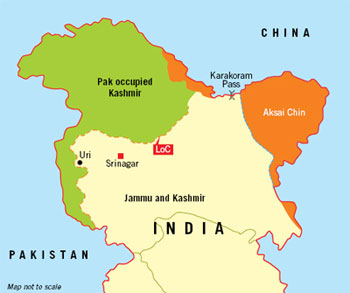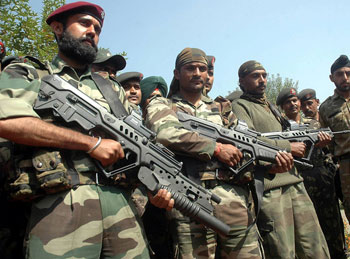INDIAN ARMED FORCES CHIEFS ON OUR RELENTLESS AND FOCUSED PUBLISHING EFFORTS

The insightful articles, inspiring narrations and analytical perspectives presented by the Editorial Team, establish an alluring connect with the reader. My compliments and best wishes to SP Guide Publications.

"Over the past 60 years, the growth of SP Guide Publications has mirrored the rising stature of Indian Navy. Its well-researched and informative magazines on Defence and Aerospace sector have served to shape an educated opinion of our military personnel, policy makers and the public alike. I wish SP's Publication team continued success, fair winds and following seas in all future endeavour!"

Since, its inception in 1964, SP Guide Publications has consistently demonstrated commitment to high-quality journalism in the aerospace and defence sectors, earning a well-deserved reputation as Asia's largest media house in this domain. I wish SP Guide Publications continued success in its pursuit of excellence.
Beyond the Surgical Strike
The Indian Army has now been given a free hand to take appropriate action against the enemy operating across the LoC from PoK.
 |
By Air Marshal B.K. Pandey (Retd) Former Air Officer Commanding-in-Chief of Training Command, IAF |



On the morning of September 18 this year, a band of four heavily armed terrorists believed to be from the Jaish-e-Mohammad (JeM) operating from across the Line of Control (LoC) in Pakistan Occupied Kashmir (PoK), launched an attack on the administrative and logistics section of a unit of the Indian Army based in Uri in the Kashmir valley. Apart from the destruction of a fuel dump, 18 soldiers of the Indian Army were lost their lives in this attack.
With the aim of giving Pakistan a befitting response to the dastardly attack, Indian Special Forces carried out a surgical strike across the LoC into PoK on the morning of September 29. For this operation, along with the Special Forces of the Indian Army that crossed the LoC on foot, Para Commandos were also inserted into the target area with the help of Mi-17 helicopters of the Indian Air Force. The operation that lasted for just under five hours, was indeed meticulously planned and professionally conducted as seven terrorist camps that were used as launch pads by the terrorists for operations across the LoC, were obliterated and 38 terrorists eliminated. The Indian Special Forces suffered no casualties in this operation.
The Indian armed forces have always possessed the capability to launch surgical strikes of this nature against terrorist hideouts, bases and launch pads; but have not been able to undertake such missions owing to the absence of political approval. Apparently, the Indian Army has now been given a free hand to take appropriate action against the enemy operating across the LoC from PoK. The Indian Special Forces are poised to undertake more of such adventures.
While the nation celebrates the highly successful counter-terror operation and rightly lauds the competence and bravery of the Special Forces, it would be necessary to look beyond this daring exercise and assess its after effects and implications for the security of the nation. In view of the paradigm shift in the approach of the Indian political leadership towards the menace of proxy war being waged by Pakistan and proactively inflict severe punishment on the perpetrators of terrorism as demonstrated so explicitly in the counter-terror operation on September 29, the sponsors of terror operations across the LoC are likely to re-evaluate the situation and recast their strategy for the future. There is a strong possibility that they may scale down cross-border terrorist attacks as they are not in a position to cope with the asymmetry in capability and match the might of the Indian Army once it has been unleashed upon them by the Indian political establishment.
Pakistan has begun beating the war drums as it has placed its Air Force on high alert. Besides, in all likelihood, Pakistan would have ordered mobilisation of her land forces not so much to launch a full scale war against India, but to be prepared for a large scale offensive by the Indian armed forces. While Pakistan will continue with these precautionary measures, it is likely that the focus of her terror operations will shift to soft targets located across the length and breadth of India. These could include airports, railway stations, large shopping malls, markets, hotels and restaurants. This tactic has been clearly demonstrated in the 26/11 attacks in Mumbai and could be replicated in metros and other large cities in India. These facilities and establishments will present soft and lucrative targets for terrorist attacks. As it would not be practically possible to sanitize or secure all such facilities against attack by well trained and motivated terrorists, India as a nation will continue to remain highly vulnerable. Even if access across land borders or sea frontiers are sealed and through airports or sea ports tightly controlled, there are already a large number of sleeper cells of Pakistan as well as their sympathisers already present in the country. This was clearly demonstrated by Indian nationals with totally anti-national agenda calling for the destruction of India during the agitation in Jawahar Lal Nehru University in Delhi.
Thus the successful operation by the Indian Special Forces on September 29 most certainly does not mark the end of the proxy war that the nation has been facing for decades. There is definitely much more to come. The nation must be prepared.





